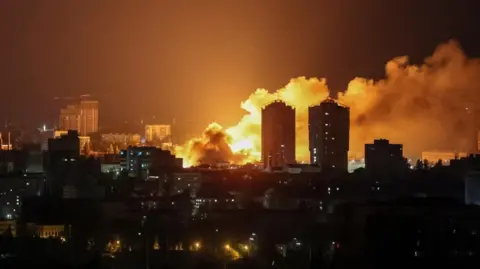On a tense Friday morning, Ukraine found itself under a massive attack as Russian forces launched a substantial series of missile and drone strikes across various regions, notably the capital city of Kyiv. Reports indicate that at least three people lost their lives and an additional 49 individuals sustained injuries as a result of this aggressive military offensive, underscoring the ever-pervasive threat that the ongoing conflict poses to the region’s stability.
The airstrikes were directed not only at Kyiv but also extended to the city of Lutsk and parts of the Ternopil region located in north-west Ukraine. President Volodymyr Zelensky confirmed the tragic casualties and indicated that the strikes involved an astonishing deployment of over 400 drones and upwards of 40 missiles, raising concerns that the number of injured individuals could further escalate as more information emerges. In direct communication through social media, Zelensky expressed the gravity of the situation, holding other world leaders accountable for their inaction in addressing the Russian aggression, suggesting that any lack of pressure on Russia exacerbates the ongoing conflict.
Russian authorities framed the missile attacks as a response to what they termed “terror attacks by the Kyiv regime,” asserting that their military efforts were aimed at neutralizing military objectives. Zelensky, on the other hand, emphasized the precariousness of Ukraine’s situation and highlighted the damaging ramifications such violent offensives have on civilians. The stark contrast in narratives illustrates the complexities and multifaceted dimensions of the war, where both sides unveil different motivations and justifications for their actions.
Before the strikes, Russian President Vladimir Putin reportedly warned his American counterpart, former President Donald Trump, of potential retaliation against Ukraine for its strikes on Russian air bases. Trump’s communication with Putin underscores the international implications of the war, marking a moment where rhetoric could lead to escalated military responses. Zelensky’s statements on social media also pointed towards the insufficiency of international resolve to impose sanctions or come together against Russian incursions, implying that lackadaisical approaches by Western leaders constitute a form of complicity in the ongoing tragedy.
Eyewitness accounts from Kyiv depicted a harrowing scene as air raid alerts forced tens of thousands of civilians to seek solace in underground shelters, with a palpable sense of tension gripping the city. Gunfire erupted intermittently from air defense systems trying to intercept the incoming drones, and the unsettling sounds of distant explosions reverberated amid chaotic panic. The local populace faced yet another day marked by a loss of safety and ongoing turmoil, familiar situations in these times of warfare.
Local officials, including Kyiv’s Mayor Vitali Klitschko, noted that four fatalities were reported in the capital, indicating the difficulty in obtaining accurate numbers during such chaotic conditions. With air raid sirens blaring and disruptions affecting essential services, residents were left grappling with uncertainties as they endured harrowing hours amid the violence.
The attacks also left their mark beyond Kyiv; Lutsk saw injuries among its citizenry, and in the Ternopil region, local authorities revealed noteworthy damage to homes and public infrastructure, painting a grim picture of a widespread assault that disrupted the daily lives of countless Ukrainians. Moreover, additional reports surfaced about Russian defense forces claiming to have intercepted 174 Ukrainian drones during the hostilities, suggesting an ongoing and reciprocal nature to the military engagements.
In the backdrop of these escalations, peace talks previously held in Istanbul remained stagnant, reflecting the challenges that lie ahead in efforts to resolve the ongoing conflict. Both parties stand entrenched in their positions, underscoring a stalemate that poses further dilemmas for diplomacy in the region.
In summary, the latest wave of strikes on Ukraine further complicates an already dire situation as both sides remain ensnared in a cycle of violence. With casualties reported and tensions exacerbating, the situation illustrates a multifaceted conflict that warrants not only immediate attention but also a strategic approach to diluting hostilities and ideally, finding a pathway to peace.



